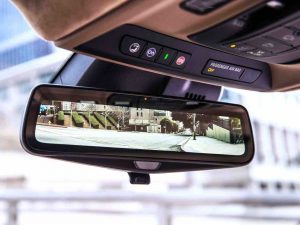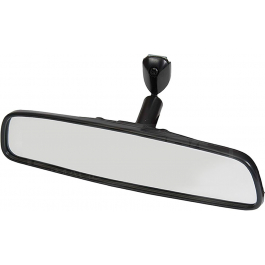Most people don’t know this – yet – but replacing a new car’s windshield can cost as much as a new transmission used to cost.
Sometimes, more.
Because it’s not just glass you’re replacing.
Embedded in the glass – part of the “assembly” – is saaaaaaaaaaaaaaaaaaaaaafety technology. It’s usually part of the rearview mirror, technically – but that’s now part of the windshield assembly in more and more new cars.
It’s no longer the simple – and generic/universal – glue it in place rearview mirror cars used to have.
The rearview mirror is almost an afterthought.
The rest of the assembly – that huge chunk of plastic that’s glued to the glass – contains sensors and cameras, integral to saaaaaaaaaaaaaaaaaaaafety systems such as Lane Keep Assist, Automated Emergency Braking and so on. Some keep track of what’s happening outside the car and some (like Subaru’s EyeSight system) also keep track of what’s going on inside the car.
Some do both.
In some cars, the rearview mirror doubles as a closed-circuit camera.
But the relevant thing is that the windshield in a modern car is no longer just a sheet of glass but an integrated system with proprietary technology baked into it.
This makes the system much more expensive to manufacture than the old-school sheet of just glass – and effectively impossible for generic/aftermarket companies to make copies of.
They could make the glass, of course. But they can’t make the tech. Not legally, anyhow – and even if that weren’t an issue, the economics would be. The tech has become so car-specific that mass reproduction of a given part (this goes beyond windshields) often doesn’t make economic sense.
In the past one size did fit all – or at least, many – when it came to automotive glass as well as many other parts. It was typical for a given make/model of car to remain pretty much the same for at least five or six years and that meant a given sheet of glass (as well as other parts) fit tens of thousands of copies of a given make/model of car built over that span of years.
This reduced the cost of those parts because the manufacturer – whether original equipment or aftermarket – could recoup manufacturing costs on less per sale because more parts could be sold. Economies of scale.
You could also find a part that fit used – at a junkyard. So long as it physically bolted up, you were good to go. Usually for much less than the cost of a new part, whether OEM or aftermarket.
But today’s car have much shorter shelf lives; the usual interval between a major makeover is down to about three or four years on average and it is now common for major incremental changes to be made year-to-year.
And cars are much more make/model and year-specific now. Trim and combination of options-specific, too.
Things no longer interchange as easily.
Your 2018 car may look like the 2016 version – but your version came with a different windshield. One that incorporates saaaaaaaaaaaaaaaaaaaaaaaaaaaaaaaaaaafety tech or other systems that weren’t yet on the menu back in ’16.
The windshield for a 2016 (or from one, at the junkyard) might physically fit. But it won’t work – because the electronics are different.
The replacement windshield for the 2016 costs say $200; $150 for the functionally identical aftermarket/generic replacement. But the same glass for the 2018 costs twice as much – because it’s no longer just the glass . . .and because there is no generic/aftermarket option.
That stone chip just got a lot more expensive.
Your insurance, too. Both the premium and the deductible. People are beginning to notice – especially after they file that first claim for a replacement windshield. They are fall-to-their-knees grateful when they find out that’s only going to cost them $100 (for the deductible) to get that $1,000 windshield.
A month later, they get the new bill – the “adjusted” premium (and deductible) which – in defense of the insurance mafia – reflects a legitimate cost.
What’s not legitimate is that we can’t opt out – of either.
We’re not allowed to buy new cars without the embedded-in-the-glass (and everywhere else) saaaaaaaaaaaaaaaaaaaaaaaafety tech, which has either been formally mandated by the government or functionally mandated by the car companies, most of which won’t sell you a car with just a windshield and just a rearview mirror anymore.
Just as they won’t generally sell you a car without at least six air bags – even though the government only mandates two.
They’ll say it’s for your saaaaaaaaaaaaaaaaaaaaaaaaafety, of course. But it doesn’t hurt – them – that it all this saaaaaaaaaaaaaaaaaaaafety ups the price you’re effectively forced to pay for the car and to fix the car.</p>
Which you’re forced to do because a cracked windshield won’t pass saaaaaaaaaaaaaaaaaaaaaaaaaaaafety inspection and without the saaaaaaaaaaaaaaaaaaaaaaaaaaafety sticker on the windshield you’re fair game for a Hut! Hut! Hutting! by armed government workers.
And to insure it – which you are legally forced to do.
What was it George Jetson used to say?
Jane! Stop this crazy thing!
. . .
Got a question about cars, Libertarian politics – or anything else? Click on the “ask Eric” link and send ’em in!
If you like what you’ve found here please consider supporting EPautos.
We depend on you to keep the wheels turning!
Our donate button is here.
If you prefer not to use PayPal, our mailing address is:
EPautos
721 Hummingbird Lane SE
Copper Hill, VA 24079
PS: Get an EPautos magnet (pictured below) in return for a $20 or more one-time donation or a $10 or more monthly recurring donation. (Please be sure to tell us you want a sticker – and also, provide an address, so we know where to mail the thing!)
My latest eBook is also available for your favorite price – free! Click here. 












https://www.wired.com/story/hackers-steal-tesla-model-s-key-fob-encryption/?bxid=5cec250afc942d3ada07ef53&cndid=13677222&esrc=Wired_etl_load&source=EDT_WIR_NEWSLETTER_0_DAILY_ZZ&utm_brand=wired&utm_campaign=aud-dev&utm_mailing=WIR_Daily_082819&utm_medium=email&utm_source=nl&utm_term=list1_p4
I guess theft insurance increases due to theft will be passed on the Tesla owners for this, right? Not just spread across all policies, right?
Geez, if only someone could come up with a small, easily replaced, purely mechanical device you put in a slot and turned to enter/activate the vehicle……
Nah, a radio transmitter that broadcasts your code to the car makes far more sense, to the senseless glass peckers.
One more thing. Anyone have an data on just how many non-Tesla EV get stolen or spontaneously ignite themselves? How many self immolate after a crash?
You have never been so right as in the article above. Today there are so many proprietary systems in new cars, that independent manufacturers just can not offer reasonably priced spare parts anymore. The car manufacturers do this on purpose and they force the customer to pay astronomical prices for spare parts that in themselves are inexpensive to make.
In Norway Nissan for instance demanded about 7000 $ for a replacing a broken information display unit for a Nissan Leaf (this is not a joke). Fortunately a new unit can be bought at EBAY for about 700 $. My wife recently paid 100 $ for four specialized spark plugs for her Toyota Yaris, but standard plugs cost about 16 $ for four of them.
What the car manufacturers do today with astronomically priced proprietary spare parts borders on swindle, and there should have been a law against it. I think (hope?) that this will sometime strike back at them hard.
Hi Jone,
Part of the problem is the Newness Factor. People get bored much more quickly; they no longer value things made to last – and cheap to keep. They want the “latest thing.” And so cars change dramatically, frequently. It is no longer typical for a car to remain in production largely the same for 8-10 years (as was previously common). Instead, most cars are completely revised/made-over after about four years and there are significant changes, year to year. One of the results of this is that fewer replacement parts are made – and they’re not made for very long. Once a car is say ten years old, critical replacement parts may no longer be available at all; or the few parts that remain are astronomically expensive – as in your example.
As a contrast, a car like my ’76 TA was made more or less the same from 1970-1981; it shared many of its mechanical parts with numerous other GM vehicles, some of them made for decades. Result? Even today – almost 50 years after it was made – I can still easily find almost any mechanical or electrical part for my car and at reasonable cost.
Unless the government bans cars like mine, they will likely still be viable to own and drive 50 years from now.
Where do you suppose your Leaf will be in ten years?
He, he – firstly, it was not I who smashed the information screen when transporting planks and braking hard. Thus I was not offered a new replacement unit from Nissan at an exorbitant price, that borders on blackmail. Nonetheless, this incident where Nissan requested a price for a new unit far beyond any reasonable mark-up, was covered well in Norwegian media. Luckily the customer could avoid Nissan completely, and he ordered a new unit from EBAY at 1/7th of Nissan’s price.
Yet, I do own a 3 years old Nissan Leaf. In about 10 – 12 years I think that it, together with a low of electric cars will be in the scrap yard. It is still so expensive to replace a worn out battery pack, that I think that many electric cars are going to be scrapped when they become about 10 – 15 years old, if not sooner. This is kind of sad, because I have heard that the electric motor will easily run one million kilometers without needing repairs.
I can see a niche market for a small tow behind trailer outfitted with a gasoline generator to bypass the spent battery packs.
Here’s a better idea: why not just put that gas (or diesel) engine under the hood and do away with all of this Rube Goldberg nonsense?!
Eric, same with my ’71 Custom 10. It’s been 22 years since paint and new engine and it’s still a nice 20 footer, but I’m feeling the need to do a really nice restoration. The last time I cut out rust and welded in a lot of patch panels, but today I can get all the new aftermarket panels I need at a reasonable price. It will also be sprayed with old school DuPont Chroma base/clear with one of my Binks #7 guns. The EPA goons can have my non compliant Binks #7 when they pry it from my cold dead hands.
The ’71 will be running strong long into the future.
It turns out lots of people don’t like the driver assist features.
https://z951.com/news/030030-survey-finds-new-auto-technology-can-annoy-drivers/
It’s strange, earlier this morning this story was all over the MSM channels, then they all disappeared.
Now the story changed to “Much of the problem increase is due to unfamiliarity with the technology—a usability issue.”
https://www.jdpower.com/business/resource/mobility-disruptors-automated-driver-assistance-systems-alarms-abound
https://www.detroitnews.com/story/business/autos/2019/06/19/korean-brands-top-j-d-powers-initial-quality-auto-rankings/1488480001/
Ok, here’s the one one I read earlier from the MSM.
https://www.cnbc.com/2019/08/27/drivers-turning-off-annoying-or-bothersome-vehicle-safety-systems.html
I doubt these high tech windshields cost much more than plain ones and the ‘calibration’ is probably fairly easy too. I doubt the engineers were allowed to add much more than few dollars to the cost of the windshield to the automaker. My guess is that the parts and service departments are taking advantage as well as the automaker itself. High tech windshield gets doubled by the automaker. Then doubled by the distributor, then doubled by the dealer. Something along those lines.
There’s no way manufacturing speed, lead time, etc took a big hit because it’s “high tech”.
Brent, Back when Chrysler was making huge engines, the only reason they weren’t all “Hemi’s” is because those engines cost $5 more to produce than the 440. I’m sure you’re right in the cost of said windshield being an significant amount more than the plain one but it’s big money to control an entire vehicle with every part put on it and that’s esp. true for passing an inspection part.
All that coded for everything is beyond most every car buyer’s keen so they just get screwed because cars, like everything else these days, are “secret”, maybe not to the degree of 9/11 but close enough to such the exhaust and make big bucks doing so.
suck the exhaust…….
The actual glass? No, it isn’t much more expensive. But the calibrations aren’t easy. It takes some very specialized and expensive equipment and some significant and expensive training. It’s a safety system and if anything isn’t done absolutely to spec and fully documented, lawsuits will erupt.
I know all this because my son-in-law does body work. He tells me the insurance companies are getting a bit miffed at what this stuff costs to repair (along with repair costs for aluminum body panels, etc.). I would expect to see insurance costs ratcheting up in a hurry Any Time Now.
This is crazy because I just got an estimate today for a new windshield due to a rock chip – and the estimate is $1100.
I read that just to re-calibrate the system can cost over a $1000. Someone at work radar unit “fell off” his brand new Honda, only 2 weeks old, he had to pay thousands to have a new one reinstalled.
On Audi’s it’s $2500 if you ever have to remove the front bumper, whether anything is replaced or not, just unplugging the sensors will lose the calibrations.
Here in South Carolina the insurance companies are required by law to replace cracked windshields at no cost. I’m sure they fold the cost of that in, of course. I had to do it once on my work van. The company came out and did it in no time, and surprisingly it didn’t result in raised premiums. I think that may be mandated too.
This raises another question: How is it that work vans, from what I’ve seen, have escaped so much of the tech that goes into everything else, even “work” trucks? Mine has the damned air bags and an easily defeated seat belt alarm, but other than that it’s pretty old school. I even insisted on manual hand crank windows.
“How is it that work vans, from what I’ve seen, have escaped so much of the tech ”
Often because corporations won’t pay for it. Simple as that.
The car industry and uncle have gone way to far.
I believe you’ll start seeing people drive ‘Roxor’ type vehicles on DOT roads more and more.
In most rural areas you can get some kind of special use tag. In one state I’m familiar with you can drive said vehicles (quads, SxS, etc…) on roads posted 40mph or under. But I’m betting that some will start testing that and driving them where they aren’t allowed (40mph+ roads) and while a few tickets may come of it, I’m guessing rural cops are going to start letting this happen more and more.
It is certainly one way of fighting the current system.
Just my 2 cents
Slap a plate on a Roxor and you would never have known it was a Jeep
What happens when you can’t get parts in 10 years, a expensive paperweight.
ive seen the car and driver windshield replacement cost and it goes over $1k easily. They regularly get rock chips and cracks due to the Michigan gravel. Its really shocking at the cost of a windshield. I’m in MN and have replaced my minivan’s windshield twice. I have a chip now and filled it but the dramatically cold weather can cause the chips to become full on cracks.
My Cherokee’s windshield has heat tape at the bottom where the wipers sit. The sales guy mentioned it and recommended I make sure my insurance has windshield replacement included. I don’t think the cameras and sensors are bonded to the windshield, just the camera mounted to the bumper (where it collects all sorts of road grime -what’s that going to cost to replace?).
If it’s like my old 2001 Chrysler minivan, it’s not a big deal, if it’s only the heat tape. I broke the windshield on it once. I had it replaced with a used windshield from a junkyard, and they had no problem making the replacement work, and it wasn’t expensive either. They were plug in’s, pretty simple actually.
I remember when GM came out with the Day/Night rearview mirror. What a life-saver that was from idiots and cops, oops, I repeat myself. West Texas sun sometimes causes one to give it up so you find your rearview in the floor. No problem, remove base, file it down to bare metal, use a quality epoxy and some duck tape to put it back on. You might wanta go over the area on the windshield with some acetone. Once stuck for 24 hours you’re good to go again for many more years.